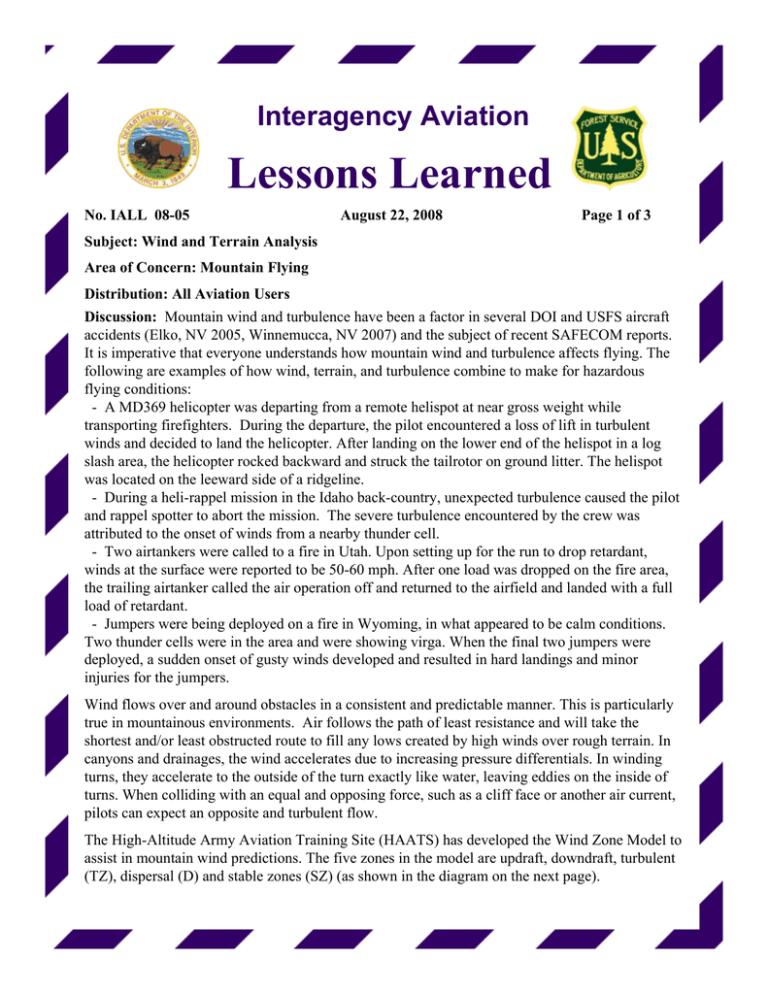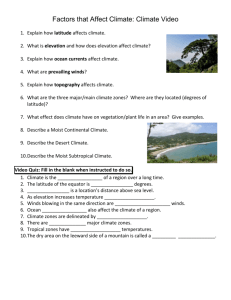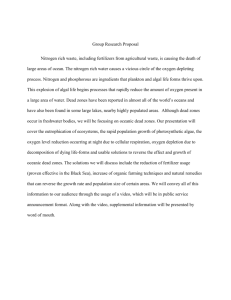Lessons Learned Interagency Aviation
advertisement

Interagency Aviation Lessons Learned No. IALL 08-05 August 22, 2008 Page 1 of 3 Subject: Wind and Terrain Analysis Area of Concern: Mountain Flying Distribution: All Aviation Users Discussion: Mountain wind and turbulence have been a factor in several DOI and USFS aircraft accidents (Elko, NV 2005, Winnemucca, NV 2007) and the subject of recent SAFECOM reports. It is imperative that everyone understands how mountain wind and turbulence affects flying. The following are examples of how wind, terrain, and turbulence combine to make for hazardous flying conditions: - A MD369 helicopter was departing from a remote helispot at near gross weight while transporting firefighters. During the departure, the pilot encountered a loss of lift in turbulent winds and decided to land the helicopter. After landing on the lower end of the helispot in a log slash area, the helicopter rocked backward and struck the tailrotor on ground litter. The helispot was located on the leeward side of a ridgeline. - During a heli-rappel mission in the Idaho back-country, unexpected turbulence caused the pilot and rappel spotter to abort the mission. The severe turbulence encountered by the crew was attributed to the onset of winds from a nearby thunder cell. - Two airtankers were called to a fire in Utah. Upon setting up for the run to drop retardant, winds at the surface were reported to be 50-60 mph. After one load was dropped on the fire area, the trailing airtanker called the air operation off and returned to the airfield and landed with a full load of retardant. - Jumpers were being deployed on a fire in Wyoming, in what appeared to be calm conditions. Two thunder cells were in the area and were showing virga. When the final two jumpers were deployed, a sudden onset of gusty winds developed and resulted in hard landings and minor injuries for the jumpers. Wind flows over and around obstacles in a consistent and predictable manner. This is particularly true in mountainous environments. Air follows the path of least resistance and will take the shortest and/or least obstructed route to fill any lows created by high winds over rough terrain. In canyons and drainages, the wind accelerates due to increasing pressure differentials. In winding turns, they accelerate to the outside of the turn exactly like water, leaving eddies on the inside of turns. When colliding with an equal and opposing force, such as a cliff face or another air current, pilots can expect an opposite and turbulent flow. The High-Altitude Army Aviation Training Site (HAATS) has developed the Wind Zone Model to assist in mountain wind predictions. The five zones in the model are updraft, downdraft, turbulent (TZ), dispersal (D) and stable zones (SZ) (as shown in the diagram on the next page). No. IALL 08-05 August 22, 2008 Demarcation Updraft Page 2 of 3 Turbulent Stable Curl Downdraft Dispersal WIND ZONES In addition, there are two other terms in the Wind Zone Model: the demarcation line is the point separating the updraft and downdraft zones, and the "curl," or low pressure, is created by the wind’s passage over or around an obstacle. The demarcation line’s angle and height is established by three factors: the velocity of the wind, steepness of the slope and the angle at which the wind strikes the slope. It can be considered an extension of the slope as it rises above and beyond the obstacle and is bent downward horizontally as it interacts with winds aloft. Its actual location becomes important in cross-country operations and when approaches are being considered to pinnacles and ridgelines (see diagram below). DEMARCATION LINES AND RESULTANT LOW PRESSURE AREAS The low-pressure area (labeled L in the above diagram) is created on the leeward side of the obstacle by the passage of the wind and is the "engine" that drives the ensuing turbulence. The wind will attempt, via the path of least resistance, to fill the low. This action initiates a pattern of turbulence, until interaction with more stable air slows the swirling patterns, allowing the air currents to sort themselves out (dispersal zone) and return to a stable flow (stable zone). No. IALL 08-05 August 22, 2008 Page 3 of 3 The updraft and downdraft zones are a result of the obstacle. The remaining three zones are a result of the creation of low pressure leeward of the obstacle. If the obstacle has sharp drop-offs on either side, then the movement to fill the low is lateral, or "wrap-around.“ The zones expand with an increase of velocity, slope angle or impact angle and contract when they decrease. Knowing this is important for two reasons. First, pilots with a little experience can judge the effects of the wind by simply studying a topographical map if the upper wind’s direction and velocity are known. They can then plan safe routing to avoid the worst of the zones. Secondly, while en route, the pilot can judge the severity of the zones by how far leeward of the obstacle he encounters the dispersal zone (light turbulence). When additional obstacles follow immediately after the initial obstacle, some zones may be eliminated altogether. This is often the case in a series of peaks or ridgelines (as depicted below). Downdraft Downdraft Downdraft TZ D SZ ABBREVIATED WIND ZONES AND STRIKE POINTS In this situation, most of the turbulent zones are smaller or absent on the initial and middle ridges. The key is if and where the downdraft zone impacts subsequent obstacles. The ensuing updraft zones can be compressed due to the strength of the downdrafts. Due to compression, the ensuing updrafts become very powerful. This has serious implications for aircraft transitioning narrow valleys. In high winds, there is very little safe maneuver room in such valleys except within the narrow confines of the updraft zones or the "curl" or low pressure. Pilots needing to execute a landing or to maneuver in this confined airspace must use great caution. Having an understanding of the wind and its interaction with terrain can mean the difference between success and failure. For further study on the wind model see: https://crc.army.mil/knowledge_online/august2008/TheWindZoneModel/tabid/912/Default.aspx.. /s/ Robert Galloway Robert Galloway Aviation Safety Manager /s/ Ron Hanks Ron Hanks Chief, Aviation Risk Management and Training Systems




